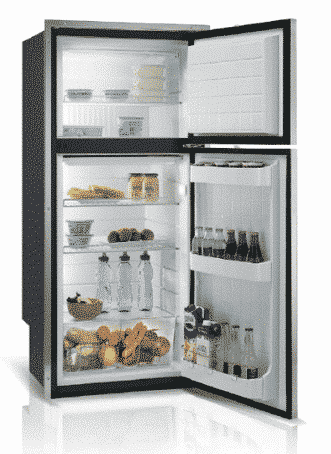Vitrifrigo/Danfoss/Lithium refrigerator test run
Here's a Danfoss Compressor refrigerator energy test I ran two years ago in my FunkWorks Lab
Dear Readers,
Here’s the numbers from my first series of tests on an 8-cubic-foot Vitrifrigo DP2600 with a 12-volt DC Danfoss compressor refrigerator powered by a single 100 amp-hour Ion-Ready Lithium battery from Briter Products.
Since this refrigerator also has a 120-volt AC input, I was able to test it on both 12-volts DC and 120-volts AC. Note the run times using the refrigerator’s built-in 12-volt connection are quite a bit longer than using a 100 amp-hour Lithium battery to power a 1,000-watt inverter which powers the Vitrifrigo’s internal 120-volt AC to 12-volt DC converter.
Test #1: With a Marinco 1,000-watt inverter
Briter Products 100 amp-hour Ion-Ready Battery discharged from 100% to 5% State of Charge
Marinco 1,000 watt pure-sine inverter
Vitrifrigo 8 cu.ft. refrigerator using its 120-volt AC supply
Average Room Temp 70 degrees F
Refrigerator run time on 1,000-watt inverter was 23 hours
Test #2: With a Galaxy 250-watt pure-sine inverter
Briter Products 100 amp-hour Ion-Ready Battery discharged from 100% to 4% State of Charge
Galaxy 250 watt pure-sine inverter
Vitrifrigo 8 cu.ft. refrigerator using its 120-volt AC supply
Average Room Temp 70 degrees F
Refrigerator run time on 250-watt inverter was 29 hours
Test #3: With a direct battery 12-volt DC input
Briter Products 100 amp-hour Ion-Ready Battery discharged from 100% to 6% State of Charge
Average Room Temp 70 degrees F
Refrigerator run time on Direct 12-volt DC was 38 hours
What about a residential refrigerator?
My 120-volt AC compressor 16-cubic-foot refrigerator/freezer in the basement eats up around 100 watt-hours of energy per hour, so that’s around 2.4 kW-hours per day. That suggests that even with an inverter that had 100% efficiency (which doesn’t exist, by the way) you might get 10 to 12 hours of run time for this refrigerator from a Lithium battery/inverter setup which can provide about 1,200 watt-hours (1.2 kW-hours) of storage capacity. Of course, your mileage will vary depending on the size and efficiency of your residential refrigerator.
Calculated 120-volt AC refrigerator run time on a 100 amp-hr Lithium battery was 10 to 12 hours
What’s the most efficient hookup?
As you can see from the bullet list above, hooking up the Vitrifrigo refrigerator’s Danfoss compressor directly to your 12-volt RV battery will be the most efficient way to run things since you don’t have the 1,000 watt inverter’s overhead of 15 watts just to run the fan, or the 250 watt inverter’s 10 watts of idle power it wastes. And, of course, you have to also factor in the 5% or so of additional power loss due to inverter inefficiencies.
Winner: 12-volt DC powering the Danfoss compressor
The bottom line appears to be that a Vitrifrigo DP2600 8-cubic-foot Danfoss compressor refrigerator uses around 1/3 of the energy of a conventional 120-volt AC, 16 cu.ft. conventional compressor refrigerator. Interpolating the data a bit for the difference of the external surface areas between the two refrigerator’s cubic foot capacities, the Vitrifrigo Danfoss compressor refrigerator uses less than 1/2 the energy of a similar-sized 120-volt AC, conventional compressor refrigerator.
This suggests that the Danfoss compressor refrigerator makes boondocking on solar power using a single 100 amp-hour Lithium Battery such as the Briter Products Ion-Ready a possibility, even with just 200 to 300 watts of solar panels.
However, to be able to power a few other 12-volt appliances while boondocking on solar panels (such as your fan, lights, pump, etc…) you’ll probably want to double this to at least 200 amp-hrs of 12-volt Lithium battery storage and 400 to 600-watts of solar panels.





No surprises here. Conversions always case losses. Also, Dont forget that the 120V is converted back to 12V internally to run the compressor. Another area where a loss occurs